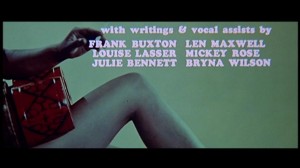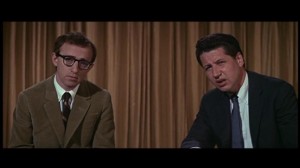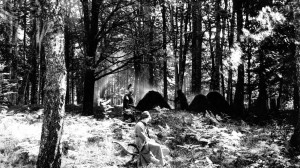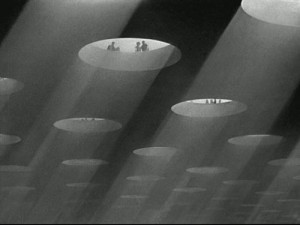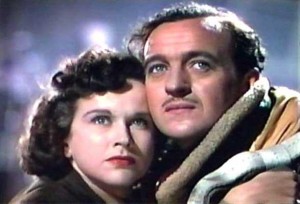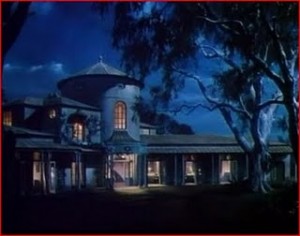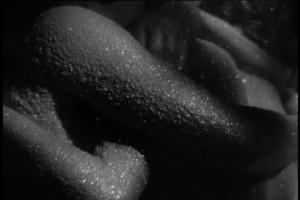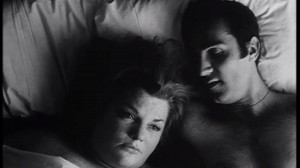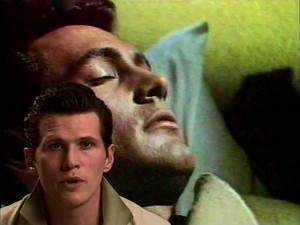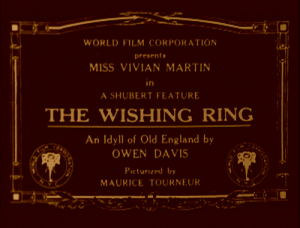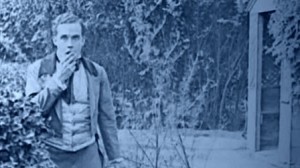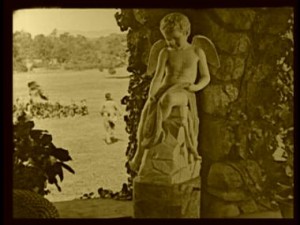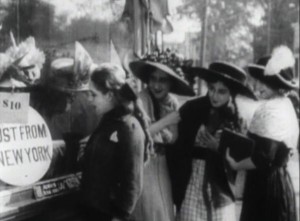From Cinema Scope #16 (Fall 2003). — J.R.
One of the more fascinating things about the linguistic options of DVDs in relation to their nationality is how often they confound expectations. It would appear that few countries show more indifference to other countries and their languages than the U.S., yet the DVDs with the greatest number of subtitling and dubbing options are often those on American labels. Conversely, when I visited Japan twice in the late 1990s, I was impressed by the cottage industries devoted to teaching foreign languages, which ranged from prime-time TV shows teaching conversational “business” English and Spanish to bilingual movie scripts sold in bookstores, some of them packaged with videos of the same films. But my recent efforts to hunt for Japanese DVDs with English or French subtitles have been in vain -— which is all the more frustrating when I come across listings for box sets devoted to Kiarostami and Godard’s Histoire(s) du Cinéma.
Attending Cinema Ritrovato, an archival film festival, in Bologna last summer, I went hunting for Italian DVDs and quickly discovered that those with Italian movies almost never come equipped with English subtitles (the restoration of The Leopard, which I noted in my last column, is a rare exception). But when it comes to English-language fare, I happily stumbled upon David Cronenberg’s Spider ahead of its U.S. release as well as a Woody Allen comedy, What’s Up, Tiger Lily? (1966) —- the first and possibly the least known, though to my taste the funniest —- hiding behind the title Che fai, rubi? I hasten to note my subsequent discovery that the same movie is out on DVD in the U.S. under its original title, though I hadn’t previously encountered it and never even thought to look for it. So maybe it’s the exoticism of a foreign context that prompts such a discovery —- the same sort of impulse that enhanced my unearthing in Melbourne of cheap DVDs of Letter from an Unknown Woman and Jet Pilot, both with Chinese subtitles. (Hunting for jazz CDs in Tokyo, I was both charmed and bemused to discover that they’re almost invariably arranged alphabetically by first name, which similarly provokes a refreshing turnaround of one’s usual reflexes.)
***
To the best of my knowledge, the Danish Film Institute’s PAL release of Carl Dreyer’s Der var engang (Once Upon a Time, 1922) is the first time an archive has made a film restoration available in this manner. Though the film is still far from complete, the DFI, which was kind enough to send me a review copy, has done an excellent job of using production stills and explanatory intertitles to fill in the missing pieces, yielding 75 minutes with optional English translation and excellent piano accompaniment by Neil Brand. The only possible catch is that the DFI may not yet be equipped to handle credit-card purchases. (Direct your enquiries to “Boghandel Cinematek” <bookshop@dfi.dk>.) Unlike The Parson’s Widow (1920) and Master of the House (1925) — two Dreyer comedies that haven’t yet made it onto DVD, both of which deal with husbands exploiting wives [2014 note: both are now available] —- this somewhat lesser comedy, which starts off as a Lubitsch-style palace farce before turning into a rustic melodrama, runs variations on The Taming of the Shrew. I was first alerted to its availability by the excellent Dreyer web site; check out Nick Wrigley’s useful review at www.carldreyer.com/resources/dervarengangdvd.html for more details. [2014: Sorry — this site and link no longer function.]
***
After the inspired recent releases of three separate three-disc sets —- Erich von Stroheim’s Blind Husbands, Foolish Wives, and Queen Kelly on Kino Video, Krzysztof Kieslowski’s The Decalogue on Facets Video, and Kieslowski’s Three Colors (Blue, White, and Red) on Miramax Home Entertainment, all with copious extras —- the inflation of other releases to more than one disc for arbitrary reasons is all the more irritating. One of the dumbest excuses to date for bringing out a two-disc set is Studio Canal’s region 2 release of Le procès, the French title of Orson Welles’ 1963 adaptation of Franz Kafka’s The Trial, in two restored versions. One is Welles’ original and the other is a completely useless pared-down version, seven minutes shorter, which Welles had nothing to do with.
But the extras on this are worthy of note: not so much the untranslated and mediocre 38-minute French documentary about the film, which is useful only for the interview with cinematographer Edmond Richard, as the legendary sequence in which Joseph K. (Anthony Perkins) consults a computer expert (Katina Paxinou) about his legal dilemmas, which Welles cut from the film just prior to its release. The sound of this sequence is unfortunately still missing, and it’s too bad Studio Canal didn’t bother to fill in the missing dialogue with subtitles (as is done with some missing scenes in MGM’s new DVD of Billy Wilder’s The Private Life of Sherlock Holmes) —- something that easily could have been done because The Trial’s script, including this sequence, was published in both French and (translated) English several years ago.
A much more creditable recent French release is Editions Montparnasse’s PAL edition of Jean Renoir’s 1939 La règle du jeu, digitally restored and complete with English titles. This also has an accompanying documentary, but a far superior one —- a 42-minute analysis taken from the TV series Image par Image, derived from texts by critic Jean Douchet and directed by Pierre-Oscar Levy. (Based on the ads, it would appear that BFI Video’s own recent DVD of the film contains the same documentary.)
***
After seeing a beautiful restoration in Bologna of Michael Powell and Emeric Pressburger’s A Matter of Life and Death (1946) — Powell’s personal favorite of his features, introduced by his widow Thelma Schoonmaker (who edits Martin Scorsese’s features) —- I was moved to ask her why it isn’t available on a Criterion DVD, unlike so many other key works of Powell. The answer has something to do with American remake rights — which sound almost as silly as the film’s American title, Stairway to Heaven — although apparently this will get sorted out eventually. [2014 footnote: It did.] In the meantime, Carlton Video in the U.K. has a beautiful region 2 DVD of the film.
For 40s Technicolor that still looks comparably lush and nuanced, check out Image Entertainment’s U.S. DVD of Alfred Hitchcock’s Under Capricorn (1949). No extras are provided, but as with Image Entertainment’s concurrent release of another melancholy love story, Fritz Lang’s You Only Live Once (1937), the opportunity to see a neglected classic in near-optimal form should be enough.
***
While we’re on the subject of Criterion, two major recent efforts on their part have got to be their multifaceted editions of Alain Resnais and Marguerite Duras’s Hiroshima, mon amour (1959) and Leonard Kastle’s singular The Honeymoon Killers (1969), both of which add appreciably to our knowledge and understanding of these highly dissimilar masterpieces. The Kastle film has been marginalized in so many different ways over the years, and for so many different reasons (such as a one-shot director mainly known as an opera composer, and an uncanny mix of melodrama and realism with anachronistic period elements) that it’s been ridiculously easy to overlook. I accuse myself in this regard, for I received this DVD soon after putting the final touches on a list of my 1000 favorite films for a forthcoming collection (Essential Cinema: On the Necessity of Film Canons, to be brought out next year by Johns Hopkins University Press), and was mortified to discover that I’d somehow omitted The Honeymoon Killers. For its elaborate production history and its extensive analysis, Robert Fisher’s video interview with Kastle alone makes this a DVD worth having, and Scott Christianson’s detailed dossier on the real-life crime story of “Lonely Hearts” killers Ray Fernandez and Martha Beck looks like it could be an equally valuable resource.
***
Because the pleasure and possibilities of indexing are crucial to what makes DVDs superior to videos, it seems only natural that Mark Rappaport’s trilogy of essay films indexing sexual and gender stances of mid-century movies with clips —- Rock Hudson’s Home Movies (1992), From the Journals of Jean Seberg (1995), and The Silver Screen: Color Me Lavender (1998) —- should be available on DVD. But until recently, only the second of these was in stores. Now Water Bearer Films has brought out the other two, packaging the first of these with Rappaport’s bizarre and orgiastic 1971 short Blue Streak and the third with a recent short video commissioned by New York’s Jewish Museum that extends Rappaport’s indexing method, John Garfield. (Both DVDs also contain Rappaport trailers and a “T-shirt gallery”.)
***
Finally, one of the best archival DVDs to have come along lately might be easily overlooked if you encounter it in stores, because a superficial glance at it suggests it’s just a documentary: Thomas Hanlon’s Before Hollywood There Was Fort Lee, New Jersey. But even though this Image Entertainment DVD contains only an abridged version of Hanlon’s 1964 film, it also includes a good many other glimpses of American filmmaking in the teens: one entire feature by the great Maurice Tourneur (father of Jacques), The Wishing Ring (1914); an abridged version of another in which he also appears as himself (A Girl’s Folly, 1917); and D.W. Griffith’s The New York Hat (1912), with Mary Pickford and Lionel Barrymore.

